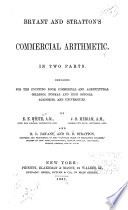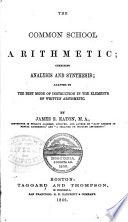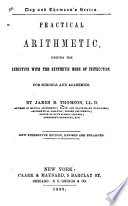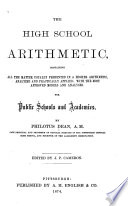 Given the first term, last term, and common difference, to find the number of terms. RULE. — Divide the difference of the extremes by the common difference, and the quotient increased by 1 is the number of terms. Given the first term, last term, and common difference, to find the number of terms. RULE. — Divide the difference of the extremes by the common difference, and the quotient increased by 1 is the number of terms.  The Common School Arithmetic ... - Page 308by James Stewart Eaton - 1868 - 312 pagesFull view The Common School Arithmetic ... - Page 308by James Stewart Eaton - 1868 - 312 pagesFull view - About this book
 | Emerson Elbridge White - Arithmetic (Commercial), 1861 - 1861 - 348 pages
...one. (3). The first term, common difference, and last term being given to find the number of terms. RULE. — Divide the difference of the extremes by the common difference, and add 1 to the quotient. (4). The first term, number of terms, and last term being given to find the... | |
 | James Stewart Eaton - Arithmetic - 1864 - 322 pages
...is the common difference multiplied by one less than the number of terms. Hence, conversely, R0LE. Divide the difference of the extremes by the common...common difference is 4 ; what is the number of terms ? =?§+1 = 7 + 1 = 8, Ana. 372. PROBLEM 4. To find the sum of a series, the extremes and number of... | |
 | James Stewart Eaton - Arithmetic - 1866 - 328 pages
...PROBLEM 3. To find the number of terms, the extremes and common difference being given. By Art. 368 it is evident that the difference of the extremes...common difference is 4 ; what is the number of terms ? 3±I^ + 1=| +1=7+1=8, Ans. 2. The common difference in the ages of the children in a family is 2... | |
 | James Bates Thomson - Arithmetic - 1868 - 412 pages
...of the series ? 416. To find the number of terms, when the extremes and common difference are given. Divide the difference of the extremes by the common difference, and the quotieat increased by 1 will be the number of terms. 6. If the extremes are 2 and 53, and the common... | |
 | John Fair Stoddard - Arithmetic - 1868 - 428 pages
...differencef to find tlie number of terms. ANALYSIS. — Since, a + (n — l)c=l. n= — +1. Hence, the c Rule. — Divide the difference of the extremes by the common difference, and increase the quotient by 1. 1. The first term is 8, the last term 203, and the common difference 5... | |
 | Benjamin Greenleaf - Arithmetic - 1871 - 350 pages
...the number of differences ; therefore 9 -)- 1 = 10 is the number of terms in this series. Hence the RULE. — Divide the difference of the extremes by...common difference, and the quotient, increased by 1, will be the number, of terms. EXAMPLES FOR PRACTICE. 1. If the extremes of a series are 4 and 44, and... | |
 | Robert Stewart (of Dundee.) - Arithmetic - 1871 - 248 pages
...their ages? CASE III. When the extremes and common difference are given, to find the number of terms. RULE.— Divide the difference of the extremes by the common difference, and add 1 to the quotient for the number of terms. 8. If the extremes of an arithmetical series be 4 and... | |
 | Joseph Ray - 1856 - 400 pages
...39. Ant. 3j ART. 413. To find the number of terms, when the extremes and common difference are known. RULE. — Divide the difference of the extremes by the common difference, and add 1 to the quotient. 1. What is the number of terms in a series whose extremes are QL and 42, and... | |
 | Philotus Dean - Arithmetic - 1874 - 472 pages
...— 1) d, it is plain that (I — a) ч- = n — 1, and that ((I — a) ч- d) + 1 — n. Hence the Rule. — Divide the difference of the extremes by the common difference, and add 1 to the quotient. EXAMPLES FOR PRACTICE. 1. The extremes are 2 and 30, and the common difference... | |
 | Horatio Nelson Robinson - Arithmetic - 1875 - 462 pages
...equal to the common difference multiplied by the number of terms less 1, (677), we have tho following RULE. Divide the difference of the extremes by the common difference, and add I to the quotient. EXAMPLES FOR PRACTICE. 1. The extremes of an arithmetical series are 5 and 75,... | |
| |